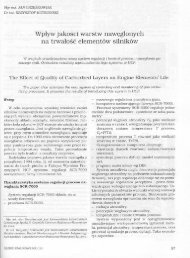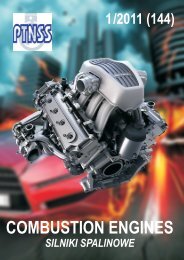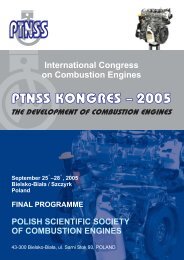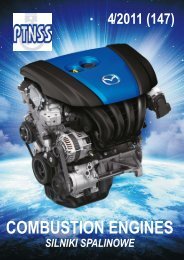Create successful ePaper yourself
Turn your PDF publications into a flip-book with our unique Google optimized e-Paper software.
Symulacja procesu spalania w dwupaliwowym silniku z dzieloną dawką oleju napędowego<br />
be of paramount importance in the transitory period of CNG<br />
implementation in the market.<br />
The decreasing efficiency at part loads is the basic problem<br />
of dual fuel diesel engines. This pushed the authors of<br />
this paper to embark on a research on the activation of the<br />
combustion of gas-air mixtures under part load conditions.<br />
In widely used common rail systems the activation of combustion<br />
was attempted through diesel fuel dose division.<br />
The authors assumed a diesel fuel dose division into two<br />
identical fuel doses injected at different times (constituting<br />
20% of the total energy supplied in the engine work cycle).<br />
The first fuel dose was to initiate the combustion in a time<br />
resulting from earlier engine tests research. The second dose<br />
injected during active combustion was to maintain the fading<br />
combustion of the gas mixture.<br />
The test results have confirmed the assumption on the<br />
positive impact of fuel dose division on the combustion<br />
process in a dual fuel engine, which, as a consequence,<br />
leads to an increase in the engine overall efficiency and an<br />
improvement of its ecological properties, particularly a drastic<br />
decrease in the NO x<br />
emission, exhaust opacity. Fuel dose<br />
division also reduces the engine noise level and improves its<br />
even operation [5, 8, 9]. Positive effects of the tests allow<br />
a supposition that this system could be introduced in dual<br />
fuel traction engines.<br />
Laboratory engine tests were preceded by a development<br />
of a theoretical model of combustion involving fuel<br />
dose divisions and a simulation research. This facilitated<br />
the selection of the parameters of the fuel doses of diesel<br />
oil and natural gas. The developed model and the simulation<br />
research have significantly reduced the range of the engine<br />
laboratory tests.<br />
2. The theoretical model of combustion in a dual<br />
fuel engine with a diesel fuel dose division<br />
The basic assumption behind the research is the division<br />
of the liquid fuel into two identical doses injected at different<br />
times by the common rail system. The controller opens and<br />
closes the injector by changing the control times that for the<br />
sake of easier control are converted into angular values. The<br />
schematic of the division has been presented in Fig. 1.<br />
The division of the dose of diesel oil results in a different<br />
combustion of the individual doses.<br />
– The first dose is self-ignited after a delay time characteristic<br />
of the liquid fuel and the conditions inside the combustion<br />
chamber. Due to the size of the fuel dose (half of the mass<br />
of a single dose) in the self-ignition delay time almost the<br />
whole fuel evaporates and mixes with air. The combustion<br />
rate of this fuel portion is determined by the rate of the<br />
chemical reactions and is very high.<br />
– The second fuel dose injected with a delay in the phase<br />
of active combustion reacts immediately as the injection<br />
continues. The combustion rate is dependent on the<br />
evaporation rate and fuel injection. It is a classic diffusive<br />
combustion and is relatively slower.<br />
The above- described differences in the combustion of<br />
the pilot and the additional fuel doses substantiates the need<br />
napędowym. Może to mieć duże znaczenie w przejściowym<br />
okresie wprowadzania CNG.<br />
Malejąca sprawność przy częściowych obciążeniach<br />
jest podstawowym problemem dwupaliwowych silników o<br />
zapłonie samoczynnym. Skłoniło to autorów tego artykułu<br />
do podjęcia badań związanych z aktywizacją spalania mieszanin<br />
gaz-powietrze w warunkach częściowego obciążenia.<br />
Wobec powszechnie stosowanych układów zasobnikowych<br />
typu common rail aktywizację spalania mieszanin gazowych<br />
starano się realizować przez podział dawki ON. Przyjęto<br />
zasadę podziału dawki ON, stanowiącej ok. 20% całości<br />
energii dostarczanej w cyklu pracy silnika, na dwie jednakowe<br />
dawki wtryskiwane w różnym czasie. Dawka pierwsza<br />
miała za zadanie inicjację spalania w czasie wynikającym z<br />
wcześniejszych badań silnika. Dawka druga, wtryskiwana w<br />
czasie aktywnego spalania, miała za zadanie podtrzymywać<br />
zanikające spalanie mieszaniny gazowej.<br />
Wyniki badań potwierdziły założenia o pozytywnym<br />
oddziaływaniu dzielonej dawki na proces spalania w silniku<br />
dwupaliwowym, co w efekcie prowadzi do wzrostu<br />
sprawności ogólnej silnika i poprawy jego ekologicznych<br />
właściwości, a szczególnie radykalnego zmniejszenia NO x<br />
i<br />
zadymienia spalin, zmniejszenia hałaśliwości oraz poprawy<br />
równomierności pracy silnika [5, 8, 9]. Pozytywne efekty<br />
badań pozwalają przypuszczać, że system ten może być<br />
wprowadzony w trakcyjnych silnikach dwupaliwowych.<br />
Badania hamowniane silnika były poprzedzone opracowaniem<br />
modelu teoretycznego spalania w silniku z<br />
dzieloną dawką inicjującą oraz wykonaniem badań symulacyjnych.<br />
Ułatwiło to dobór parametrów regulacyjnych<br />
wtryskiwanych dawek oleju i gazu. Opracowany model<br />
i badania symulacyjne skróciły znacznie zakres badań<br />
hamownianych silnika.<br />
2. Teoretyczny model spalania w silniku<br />
dwupaliwowym z podziałem dawki oleju<br />
napędowego<br />
Podstawowym założeniem badań jest podział paliwa<br />
ciekłego na dwie jednakowe dawki wtryskiwane w różnym<br />
czasie przez sterownik układu CR. Sterownik otwiera i zamyka<br />
wtryskiwacz przez zmiany czasów sterowania, które<br />
dla wygody obsługi przeliczone są na wartości kątowe.<br />
Schemat podziału przedstawiono na rys. 1.<br />
Fig. 1. Schematics of the division of the diesel oil dose<br />
Rys. 1. Schemat podziału dawki oleju napędowego<br />
Podział dawki oleju napędowego powoduje zróżnicowanie<br />
spalania poszczególnych dawek.<br />
– Dawka pierwsza ulega samozapłonowi po okresie opóźnienia<br />
charakterystycznym dla paliwa ciekłego i warunków<br />
panujących w komorze spalania. Z uwagi na wielkość<br />
44 <strong>COMBUSTION</strong> <strong>ENGINES</strong>, No. 4/2012 (151)












